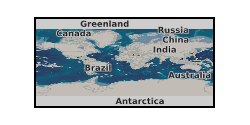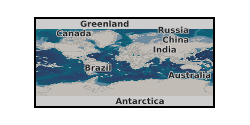Viscosity
Type of resources
Topics
Keywords
Contact for the resource
Provided by
Years
Formats
Update frequencies
-

A model of mantle viscosity inferred from the seismic model GLAD-M25 using a method described within Lloyd et al. (2024). Model stored in NETCDF4 format with the following dimensions: depth(201), latitude(631), longitude(721). Latitude and longitude spacings are equal, while those for depth are variable, being adapted to the background earth model. Andrew J Lloyd, Ophelia Crawford, David Al-Attar, Jacqueline Austermann, Mark J Hoggard, Fred D Richards, Frank Syvret, GIA imaging of 3-D mantle viscosity based on palaeo sea level observations – Part I: Sensitivity kernels for an Earth with laterally varying viscosity, Geophysical Journal International, Volume 236, Issue 2, February 2024, Pages 1139–1171, https://doi.org/10.1093/gji/ggad455
-

This dataset holds the output of all the simulations in the Open Access article - Garel, F., S. Goes, D. R. Davies, J. H. Davies, S. C. Kramer, and C. R. Wilson, Interaction of subducted slabs with the mantle transition-zone: A regime diagram from 2-D thermo-mechanical models with a mobile trench and an overriding plate, Geochem. Geophys. Geosyst., 15, 1739-1765, doi 10.1002/2014GC005257, 2014.
-

Ab initio trajectories for the equilibrated MgO-SiO2-H2O melts at T = 1800 K and 3000 K are provided as "XDATCAR" files output directly from VASP for each simulation interval. Corresponding stress tensor components, required for calculation of viscosity via the autocorrelation function, together with the energy, temperature, and pressure are also provided for each iteration of the equilibrated trajectories. A full data inventory is provided in the READ_ME.txt file.
-

Data shows the composition (in wt. %) and the modelled temperature-viscosity relationship (800-1600 degrees) for various generic compositions of magmas and variable water contents. These data are used for the viscosity curves shown in figure 11 of Kendrick and Lavallée, 2022 (https://doi.org/10.2138/rmg.2022.87.20). The data involve only idealised compositions, not real samples, and the data was compiled at the University of Liverpool, UK. These data were compiled in 2021. The generic magma compositions were input into the open access Viscosity calculator "GRD", available at; https://www.eoas.ubc.ca/~krussell/VISCOSITY/grdViscosity.html and the resulting temperature-viscosity relationship for each generic composition was generated, providing the lines used in Fig. 11 of the review paper Kendrick and Lavallée, 2022. These data help understanding the viscosity-temperature relationship of different composition magmas with different dissolved water content.
-
Spatial and temporal datasets for shear-thinning and Newtonian small-scale analogue dyke experiments

These data consist of spatial and temporal datasets for 7 different small-scale laboratory experiments of fluid-driven fractures, described in the paper The hidden internal flow dynamics of shear-thinning magma in dikes (Kavanagh et al., 2025, accepted in AGU Advances, March 2025). These experiments, conducted at the University of Liverpool, are analogue models of magma transport via flux-driven dykes. The 7 experiments are named HEC1, HEC2, HEC3, XG1, XG2, W1, W2. Experiments HEC and XG involved the injection of a shear-thinning fluid (a hydroxyethyl cellulose polymer (HEC) and xanthan gum solution (XG)), whilst experiments W1 and W2 involved Newtonian water injections. Experiments HEC1, HEC3, XG1 and W1 were ‘seeded fluid experiments’ or ‘PIV experiments’, whilst experiments HEC2, XG2 and W2 were ‘seeded gelatine experiments’ or ‘dyke-thickness experiments’. We provide the raw experimental data along with the Matlab scripts used to process and plot the data. Further information is provided in the containing README documents.
 NERC Data Catalogue Service
NERC Data Catalogue Service